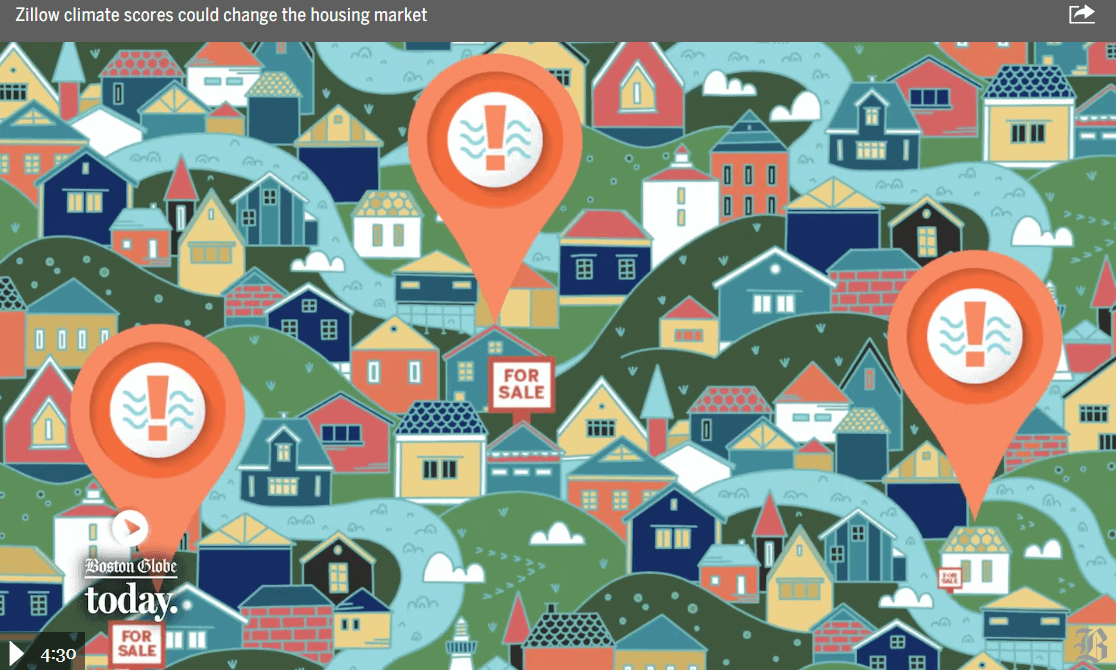Zillow 气候评分可能会改变房地产市场

【中美创新时报2024 年 10 月 19 日编译讯】(记者温友平编译)Zillow 在其待售列表中添加了气候风险数据 房地产行业并非所有人都对此感到高兴。《波士顿环球报》记者Sabrina Shankman对此作了下述报道。
“位置,位置,位置!”Zillow 列表大声疾呼。这栋 Revere 住宅——一套四居室,二楼有水景,售价不到 50 万美元——正在等待合适的买家。
或者,位于 Haverhill 的两居室两浴室怎么样,它位于“宁静的河滨”附近,拥有令人惊叹的黄色南方松木天花板?或者,这栋位于 Humarock 的舒适三居室季节性住宅怎么样——距离河流和海滩仅几步之遥,“是放松和娱乐的绿洲”?
这些房子听起来都像是人们梦寐以求的房子——或者,如果你继续阅读,看看 Zillow 对这些房产还说了什么,你会发现,这些房子简直就是噩梦:根据这家热门房地产网站最近在其待售房产列表中添加的一项新气候风险评估,这些房子都面临严重或极高的洪水风险。
风险评分影响了马萨诸塞州的大量房产:超过 15 万处,在全国范围内,Zillow 上近 13% 的新房源被评估为面临重大洪水风险。
“这就是气候变化对住房的现实,这就是这些信息如此重要的原因,”Zillow 首席经济学家 Skylar Olsen 说。
过去几周,飓风海伦和米尔顿给东南部大部分地区的房屋和财产造成了数十亿美元的损失,这一现实得到了残酷的体现。
Zillow 依赖气候风险金融建模公司 First Street 的数据,使用 1-10 的评分来评估洪水、火灾、风、空气质量差和高温的风险。马萨诸塞州沿海地区的海平面比一个世纪前高出 14 英寸,对房产的最大风险似乎是洪水,无论是沿海地区还是内陆河流附近。
First Street 气候影响研究负责人杰里米·波特 (Jeremy Porter) 表示,这种信息结合了历史洪水数据和气候变化将如何增加海平面和降水量的预测,已经存在了几年,但主要由机构投资者使用。“我们的目标是确保每个人都能理解气候风险,”他说。其他网站,包括 Redfin 和 Realtor.com,近年来也提供了来自 First Street 的气候风险数据,但最受欢迎的房地产网站 Zillow 的加入标志着市场饱和这些信息的重大转变。
洪水预测基于联邦紧急事务管理局的数据以及美国宇航局的全球气候模型。 Zillow 上显示的分析反映了未来大致遵循我们目前的轨迹,即温室气体排放持续存在,到本世纪末,地球温度将比工业化前高出 4.3 至 5.4 华氏度。
马萨诸塞州房地产经纪人协会首席执行官 Theresa Hatton 表示,近年来,随着极端天气的影响越来越严重,购房者越来越多地询问气候风险。
Hatton 表示,Zillow 上的新风险评分将使买家“对这些房产相关的风险更加谨慎和认知”,并且更有可能确保自己拥有合适的保险,如果他们决定继续购买可能存在高风险的房产。
但并不是房地产行业的每个人都很高兴。
“它让人们对我的房源产生了通常不会产生的想法,”代表 Revere 四居室卖家的 Hingham 房地产经纪人 Dorothy McLaughlin 说。这处房产距离海岸线有数个街区,位于 MBTA 轨道后面,已经需要购买洪水保险。但在麦克劳克林看来,洪水不太可能会冲到这所房子。
“你怎么知道 35 年后气候会怎样?”她说。
然而,这正是数据试图预测的结果。对于这所房子,Zillow 分析显示今年发生洪水的可能性只有 4%。但随着海平面上升和风暴加剧,未来 15 年内这一风险将上升至 72%,未来 30 年内将上升至 97%。
在 Scituate,房地产经纪人 Andrea Campbell 表示风险评分也不能反映全貌。Zillow 的评分基于模型,而不是房屋检查。“他们没有考虑到房产上的实际结构,”她说,并指出对于她拥有的房源,Zillow 给出的洪水风险为 9 分(满分 10 分),但该房源建在 55 个混凝土柱上。“当谈到洪水时,海拔高度非常重要。”
查尔斯河流域协会执行董事 Emily Norton 表示,Zillow 房源是一个良好的开端,但她指出,该州在应对洪水风险方面还有很长的路要走。根据自然资源保护委员会的分析,马萨诸塞州是仅有的 14 个州之一,也是新英格兰地区唯一一个不要求在出售房产时披露洪水风险的州。
“有关于铅的披露,也有关于其他事项的披露。为什么不披露洪水?”Norton 说。因此,马萨诸塞州的买家可能会在不知情的情况下签署一栋经常被洪水淹没的房屋的抵押贷款,而且随着气候变化,洪水可能会更多。
目前,Zillow 上提供的数据将“对子孙后代有益”,布鲁克林的经纪人 Evan Blaustein 说,他鼓励他的客户思考如何最大限度地减少新房产产生的碳排放。
他说,虽然 Zillow 的新评级很有用,但它们也可能使那些房产突然被标记为高风险的卖家陷入困境。 “这显然是很多房主都会担心的问题。”
马萨诸塞州的潜在买家还面临着另一个现实:住房短缺。
“住房数量不足以产生重大影响,”马萨诸塞州房地产经纪人协会的 Hatton 说。 “它的作用是,让买家更加谨慎,并认识到与这些房产相关的风险。”
这意味着在销售前,必须提前知道必须做出一些改变,或者可能需要额外的保险。这也可能很棘手。虽然专家表示,保险公司不太可能像在加利福尼亚或佛罗里达那样逃离马萨诸塞州的高风险地区,但保费预计将反映出气候变化风险的增加。一些公司可能会拒绝为被认为风险过高的房产投保洪水保险。
对于 Rebecca Kleppe 来说,这一切都有点令人费解,她在哈弗希尔的两居室公寓因极度洪水风险而获得了 10/10 的评分。当她在 2006 年购买公寓时,她选择了距离梅里马克河近一个街区的公寓,因为她知道开发区内其他靠近河流的公寓近年来被洪水淹没了。她说她没有遇到任何问题,尽管她被要求购买额外的保险。
“这对我来说听起来不太真实,”她说。
但好消息是,她不再担心 Zillow 评分会吓跑潜在买家:“我已经接受了报价。”
附原英文报道:
Zillow added climate risk data to its for-sale listings. Not everyone in the real estate game is happy.
By Sabrina Shankman Globe Staff,Updated October 17, 2024
Zillow climate scores could change the housing market
“Location, location, location!” screams the Zillow listing. This Revere home — a four-bedroom with second-floor water views for less than $500,000 — is just waiting for the right buyer.
Or how about the two-bedroom, two-bath in Haverhill, located near a “serene riverfront” and boasting a stunning yellow Southern pine ceiling? Or what about this cozy three-bedroom seasonal home in Humarock — a short stroll from the river and the beach, “an oasis for relaxation and fun”?
They all sound like the kind of homes people dream about owning — or, maybe, are a nightmare to own, if you read on to see what else Zillow has to say about the properties: they all are at severe or extreme risk of flooding, based on a new climate risk assessment the popular real estate site has recently added to its listing of properties for sale.
The risk scores affect an enormous number of properties in Massachusetts: more than 150,000, and nationwide, nearly 13 percent of new listings on Zillow are now assessed as being at major risk of flooding.
“That’s the reality of climate change to housing, and that’s why this information is so important,” said Skylar Olsen, chief economist at Zillow.
That reality was brutally enforced over the past few weeks as hurricanes Helene and Milton inflicted billions of dollars of damage to homes and properties across a substantial part of the Southeast.
Zillow is relying on data from First Street, the climate risk financial modeling firm, using a 1-10 score for the risk of flood, fire, wind, poor air quality, and heat. With sea levels around coastal Massachusetts 14 inches higher than a century ago, the biggest risk to properties appears to be flooding, both along the coast and inland near rivers.
This type of information, which incorporates historic flood data and layers on projections for how climate change will increase sea levels and precipitation, has been available for a few years, but it was used primarily by institutional investors, said Jeremy Porter, head of climate implications research at First Street. “Our goal was to make sure everybody can understand the climate risk,” he said. Other websites, including Redfin and Realtor.com, have made climate risk data from First Street available in recent years, but the addition of Zillow — the most popular real estate website — marks a major shift in saturating the market with this information.
The flooding projections are based on data from the Federal Emergency Management Agency, as well as NASA’s global climate models. The analysis shown on Zillow reflects a future that roughly follows the trajectory we are currently on, in which greenhouse gas emissions continue and the planet warms from 4.3 to 5.4 degrees Fahrenheit above preindustrial times by the end of the century.
In recent years, as the consequences of extreme weather have become more intense, home buyers are increasingly asking about climate risks, said Theresa Hatton, chief executive of the Massachusetts Association of Realtors.
The new risk scores on Zillow will make buyers “more cautious and cognitive about the risks associated with these properties,” Hatton said, and more likely to make sure they have the right insurance if they decide to go ahead with a property that might come with a heightened risk.
But not everyone in the real estate game is happy.
“It’s putting thoughts in people’s minds about my listing that normally wouldn’t be there,” said Dorothy McLaughlin, a Hingham-based real estate agent representing the seller of the Revere four-bedroom. The property is several blocks in from the shoreline and behind MBTA tracks and already requires flood insurance. But in McLaughlin’s opinion, it’s unlikely that the water would ever reach the home.
“How do you know what the climate is going to be in 35 years?” she said.
That’s precisely what the data is trying to project, though. For that home, the Zillow analysis gives just a 4 percent likelihood of flooding this year. But with rising seas and stronger storms, that risk climbs to 72 percent in the next 15 years and 97 percent in the next 30.
Over in Scituate, real estate agent Andrea Campbell said the risk score also doesn’t give the full picture. Zillow’s scores are based on models, not by home inspections. “What they don’t take into consideration is the actual structure that’s on the property,” she said, noting that for the listing she had, Zillow assigned a flood risk of 9 out of 10, but is built on 55 concrete posts. “Elevation means a great deal when it comes to flooding.”
Emily Norton, executive director of the Charles River Watershed Association, said the Zillow listings are a good start, but noted the state has far to go when it comes to addressing flood risks. Massachusetts is one of just 14 states — and the only state in New England — that do not require any disclosures about the risk of flooding when a property is sold, according to an analysis by the Natural Resources Defense Council.
“There’s disclosure about lead, there’s disclosure about other things. Why isn’t there disclosure about flooding?” said Norton. As such, it’s possible that a buyer in Massachusetts could sign a mortgage on a home that routinely floods, and will likely flood even more as climate change progresses, without realizing it.
For now, the data available on Zillow will be “beneficial for the future generations,” said Evan Blaustein, a Brookline-based agent who encourages his clients to think about ways to minimize carbon emissions generated by their new property.
While Zillow’s new ratings are useful, he said, they could also make it tricky for sellers whose properties have suddenly been tagged as high-risk. “That’s obviously a concern that a lot of homeowners are going to have.”
There’s also another reality that prospective buyers are contending with in Massachusetts: a housing shortage.
“There’s not enough housing for this to have a significant impact,” said Hatton, of the Massachusetts Association of Realtors. “What it’s going to do, is it’s just going to have buyers be more cautious and cognitive about the risks associated with these properties.”
That means going into a sale knowing up front that some changes will have to be made, or that extra insurance may be required. That, too, can be tricky. While experts say it’s unlikely that insurers will flee risky parts of Massachusetts in the same way they have in California or Florida, premiums are expected to reflect the increased risks of climate change. And some companies may decline flood insurance for properties deemed too risky.
For Rebecca Kleppe, whose two-bedroom condo in Haverhill notched a 10/10 score for extreme risk of flooding, it’s all a bit of a head-scratcher. When she bought her condo in 2006, she opted for one that was nearly a block away from the Merrimack River, knowing that other condos in the development that were closer to the river had flooded in recent years. She said she hasn’t had any problems, though she was required to buy extra insurance.
“This just doesn’t ring true to me,” she said.
But the good news is, she’s no longer worried about Zillow scores scaring off a prospective buyer: “I’ve already accepted an offer.”



